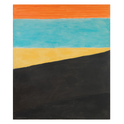Imitation, said Oscar Wilde, is the sincerest form of flattery. What could be more flattering than the French imitating the British in matters of art? This is the unimaginable twist that has taken place at Paris's museum of modern and contemporary art, the Pompidou Centre. Appropriately for a building designed by a British architect (Richard Rogers), the curators have revamped their permanent collection, exhibiting it, like we do at the Tate Modern, according to the themes of 20th-century art rather than its chronology. This spectacular display offers both the raciest tour through modern art ever devised and a concrete manifestation of the new way 21st-century art curators are thinking about 20th-century art.
The French, however, having copied us, have surpassed and eclipsed us. Never has there been such a combination of art historical funfair and iconoclastic curatorial revisionism. The groundbreaking, intellectually rigorous but somewhat dour themes picked by the Tate's curators—such as "history/memory/society" and "landscape/matter/environment"—have been replaced by the art world's version of tabloid headlines: "sex," "war," "subversion," "chaos," "melancholy." You walk in and look first at a wall along which you see a large oil of apocalyptic cascading figures, a composition that looks part computer-generated, painted in 2003 by one of the new, trendy figurative German painters, Daniel Richter. Beside it is a tortured figure, barely discernible through the thick oils, by Willem De Kooning from 1972. Next to that is a man on a toilet by Francis Bacon from 1964. And in the distance a towering sculpture of another male figure, by Thomas Schuette, executed in 1996 in one of his trademark styles of molten metal, as reflective as a mirror. This combination of works makes a staggering claim for continuity in postwar 20th-century art—a continuity of horror, bodily distortion, pain and fear.
At the heart of the exhibition there is another display of fearless curatorial bravado. On one side, behind a glass wall, is a reconstruction of a wall of the studio of the surrealist godfather and filmmaker, André Breton. There are shelves and a mantelpiece dotted with small and beautiful African figurines in dark, aged wood. A stuffed animal and the odd modernist painting by Picabia and Miró add some variety. Opposite is an installation of the same size by the French conceptualist Christian Boltanski, which consists of a minimalist grid of a hundred-odd identical heavily patina-ed tins. Each tin contains documents relating to someone Boltanski has met, though those documents can never be seen. It is a work about memory, absence and death. Boltanski belongs to a small group of French artists which includes Annette Messenger, who won the Gold Lion at the Venice biennale this year, and Sophie Calle, who creates works of art whose emotional punch comes from letting the viewer know the secret space of the artist's personal life to which you will never have satisfying access. They are about the gulf between the private world of the individual and the shared ideas of a community.
The Breton-Boltanski combination shows how the collecting habits of modernists earlier in the century became a way of making art by the end of it. Picasso, Duchamp, Breton and other artists collected objects to decorate their studios and inspire them. By the latter part of the century, the arrangement of a collection became an art form in itself. Breton's African sculptures are thus connected to Bernd and Hilla Becher's books and installations, in which they obsessively but clinically photograph industrial structures like water-towers, gas tanks and half-timbered houses. The link continues to Damien Hirst and his pharmacy project.
There is one dark sense in which this "Big Bang" exhibition says something that others haven't until now. Until this show, 20th-century art history used to be a much more festive affair. This was in many ways an American art history—a story of great formal innovations in art, which began with the cubists' reconstitution of a fragmented picture surface and reached its apogee in American colour field painters of the 1960s. We were all taught at school how the 20th century distinguished itself by the speed at which artists tore up the rulebooks and created one "ism" after another. The curators have referenced this optimistic story in the title of their show. "Big Bang" refers to the shattering break with classical painting that came with the work of Cézanne and the post-impressionists at the dawn of the last century. But as I walked round the exhibition, it was obvious that the French curators had found a different angle on the so-called American century, playing on the phrase "Big Bang." This was the most violent, angry and depressing exhibition of modern art I had ever seen—a revision of modernist art history which could only come from a continent that has suffered as much death and brutality as our own. This was a European, if not quite a French art history—an exhibition of works of art horrified at what had happened in the century in which they were made— symbolised by the vacuity of Richard Artschwager's Formica triptych, Warhol's lurid screen-printed electric chair and Giacometti's crumbling existential figures. The art of the 20th century was as much an art of despair as an art of hope.











